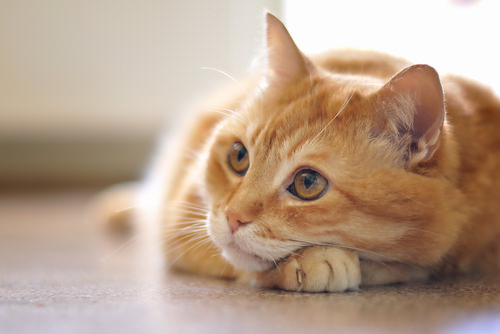Arthritis (inflammation of the joints) is one of the most common cause of pain for pets and people. It develops from normal wear and tear or can occur as a result of injury in the past. It is diagnosed by a veterinarian from physical exam findings and radiographic evidence. There are other causes of pain in cats also and they are so good at hiding pain that you might not even notice, but it is so common that you should be aware of the subtle signs.
Just because arthritis is common, does not mean that is just “normal aging”. If you think that your cat is experiencing one or more of these signs, you should tell your vet. She could be in pain and there are things we can do.
- Decreased activity
Many owners report that their cats are slower to get up and less active than when they were young. It can be more difficult to rise from a lying or sitting position with painful joints. Difficulty rising can also be a muscular problem, so ask your vet to help you tell the difference.
- Hesitance to climb
Climbing steps or scratching posts is specifically harder for sore cats because it distributes weight differently and requires being more limber and flexible than just walking. This difference in weight distribution can highlight lameness and make your cat cautious about climbing, even if she has always chosen high perches.
- Limping
Some cats will be obviously limping on one leg or another. Many times, arthritis sufferers will seem to “warm out” of the lameness as they get moving so you might not notice it all the time. This could be because the movement gradually increases circulation and helps get rid of the painful chemicals built up in the inflamed joints. Lameness, even if the cat warms out of it, should be mentioned to a vet since there are many other causes for limping.
- Not using the litter box
Sometimes patients will see a vet for inappropriate elimination (going outside the box) that is actually because of pain. If the sides of the box are too high for a stiff cat or the box is small and hard to turn around in, the cat may have some accidents and learn not to use the box.
5. Fleas and skin lesions
What? Skin lesions and fleas? Yes, if you notice skin lesions, like calluses or ulcers, your cat might have pressure sores from not feeling like getting up. He may be immobile enough that fleas have noticed him as an easy target. His joints could be discolored from licking because he does not know what to do about the pain.
It would be a shame to miss something as manageable as arthritis because you did not know it could manifest itself in these ways. If your cat is an adult or older or has suffered from orthopedic (bone related) injury in the past, it is worth a veterinary exam. You might bring back the kitten inside once you diagnose and treat what is going on.

